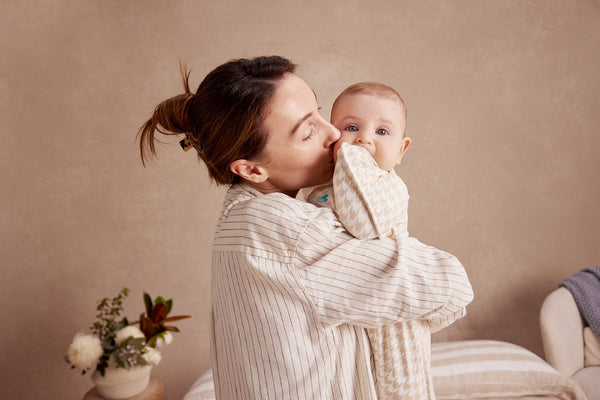2. Creating the ideal sleep environment
Wherever your baby takes their naps, ensure the environment is safe and conducive to sleep. Always follow safe sleeping guidelines.
- Ensure your baby is appropriately dressed for the climate and they are not going to get too warm or too cold during their nap
- Ensure that your baby is placed away from any air conditioning vents, direct sunlight or draughty areas
- Ensure your baby’s bassinet or cribis clear and free from obstructions, with a clean fitted sheet and mattress protector
- Keep the lights low during the day and off or low at night
- Ensure sudden or loud sound disturbances are minimized where possible. Using white noise machines can help diffuse louder external sounds.
3. Responding to tired signs
Though people often quip that babies don’t come with an instruction manual, they do in fact provide us with some helpful cues when they need to rest. Responding to your baby’s tired signs is a key part of establishing a routine for your baby’s sleep cycles. When your little one becomes overtired, it can become an uphill battle to get them to sleep. Here are some signs to look out for so you can respond to your baby’s need for sleep before they become overtired:
- Yawning
- Fussiness
- Unable to focus
- Reddish or pink tinge around the eyebrows
- Arching their back
- Rubbing eyes
If you notice your baby is showing signs off becoming tired, provide them with the opportunity to take a nap. It’s a common misconception that keeping your baby awake past the point of being tired means they will sleep for a longer period. This is not necessarily true.
4. Self-soothing & settling assistance
Self-soothing and self-settling are learned skills and key to your baby forming good sleep habits. Up until around 3-4 months of age, your baby will likely need assistance to get to sleep or back to sleep. After this time, you may notice your little one begins to demonstrate self-soothing or self-settling behaviors.
Self-soothing is where your baby uses physical behaviours or external stimuli to help regulate their emotions and assist them with falling back to sleep. You may notice signs such as your baby sucking (with a pacifier or without), sucking on hands or feet, moving their head back and forth, repositioning themselves and gentle murmurs or cries.
Self-settling refers to your baby’s ability to go from an awake state, to asleep without any assistance from you or another caregiver.
You can assist your baby with learning to self-settle and self-soothe by:
- Ensuring they are not overtired
- Ensure your baby’s needs are met before they become tired
- Sticking to a sleep routine
- Allowing your baby time when they wake from a nap to see if they begin self-settling behaviours
Managing your baby’s sleep can be an exhausting task. Whichever method or advice you choose to take, remember to always follow current Safer Sleep Guidelines. If you need help or have concerns about your baby, consult your GP, pediatrician or a child health nurse.














